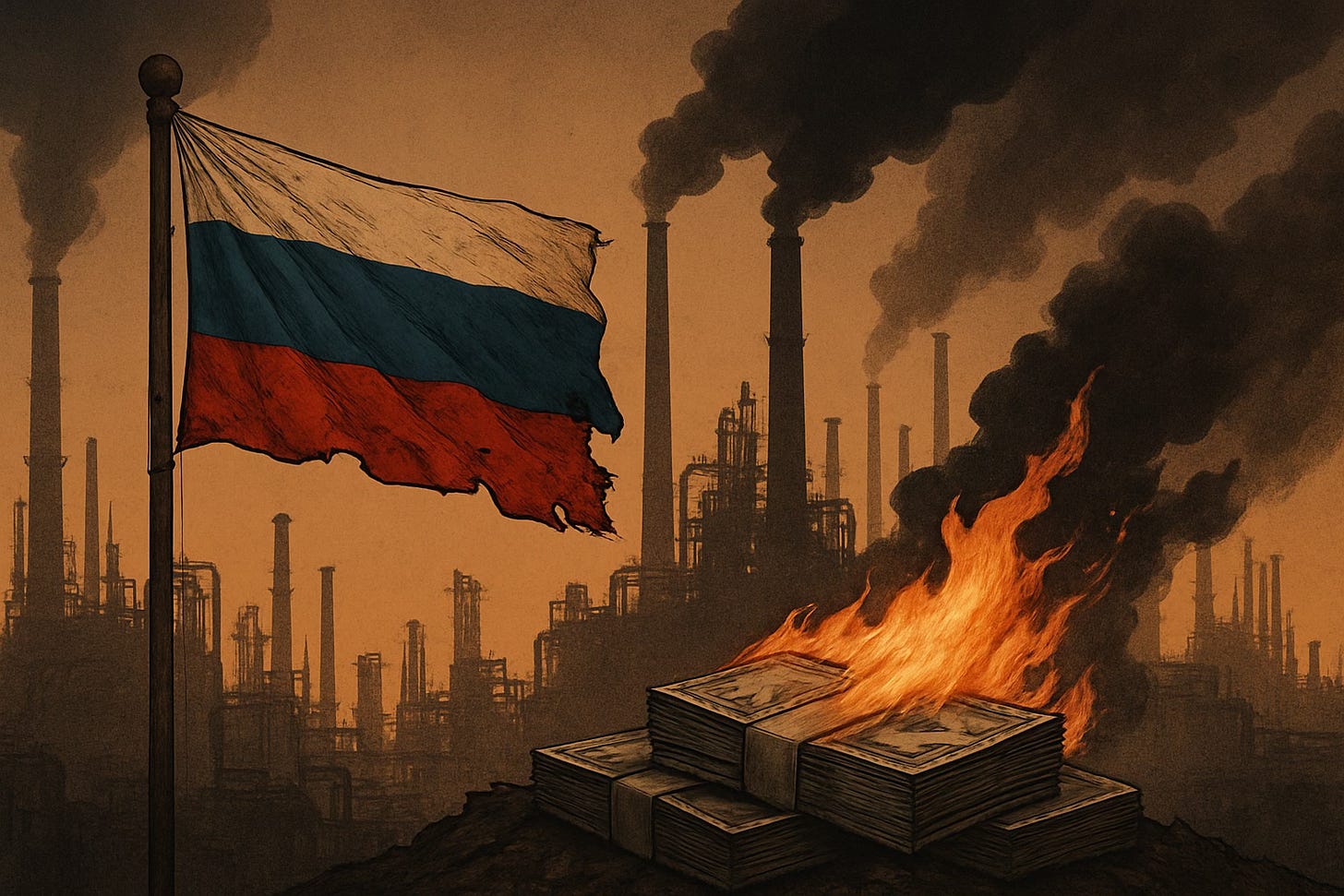Russian Economy Is Still Flying
Low, slow and burning through reserves, yet still under control
Not long ago, Western policymakers thought they had a plan. Cut Russia off from global finance, choke the ruble, and watch the war machine stall. Simple. Neat. Only it didn’t happen.
What we got instead was messier. The Russian economy is clearly losing altitude, but it’s doing so with the engines still running and the controls intact.
A 3.4 trillion ruble deficit in five months, equal to about 1.5 percent of GDP, isn’t something you just shrug off. Oil revenues, the lifeblood of the Kremlin’s budget, are down more than 14 percent from last year. In May alone, they dropped 35 percent. That should’ve been enough to send shockwaves through the system.
Yet somehow, the plane hasn’t gone down.
What we’re seeing is a rough kind of control. Improvisation. Opportunism. And a level of centralized command that market economies wouldn’t tolerate, but Russia embraces. In April, Russian crude sold for just under $55 a barrel. A year earlier, it was closer to $75. That kind of drop usually does damage. Then the Iran-Israel crisis sent Brent prices back above $76.
First-quarter GDP growth limped in at 1.4 percent. The weakest number since the early post-invasion rebound. Normally that would flash warning lights. But the Kremlin knows where to cut and where to spend. They’re tightening in some areas, pushing hard in others.
The National Wealth Fund is doing most of the heavy lifting. It still holds 11.7 trillion rubles, about 5.5 percent of GDP. That sounds reassuring until you look at the liquid part. It’s thinning out quickly. Down to just 1.3 percent of GDP. In May alone, nearly 100 billion rubles were pulled to keep things moving.
The money’s going into specific projects: a high-speed rail line between Moscow and St. Petersburg, metro systems, aircraft leasing. It’s targeted. Intentional. They’re retooling.
Non-energy revenues are still holding up, for now. VAT is rising. Corporate taxes haven’t cratered. But everyone knows this is temporary. The state is essentially performing economic triage. Keep what’s still breathing on life support, buy time, and hope for a break.
Inflation is another headache. Potatoes are up 173 percent year-on-year. Yes, potatoes. The government’s response? Cap soup prices. It sounds like a punchline, but it’s not. This is hands-on economic management, Soviet-style. No ideology. No apology.
The Central Bank is threading a needle. Rates hit 21 percent before being nudged back to 20 in June. Now officials are wondering if they hit the brakes too hard. The mere mention of a ‘soft landing’ speaks volumes.
And let’s be honest. The war is driving everything. Half of all new government spending in the first quarter went to the military. The question isn’t whether this model is sustainable long term. It’s whether it needs to be.
Look at how the financial system is shifting. The Wealth Fund is moving out of dollars and euros and into yuan and gold. This isn’t hedging. It’s a move away from the Western financial order and toward a China-aligned alternative. They’re not preparing. They’re already leaving.
Widen the lens and a different picture emerges. Russia isn’t just absorbing pressure. It’s building something else. A different kind of economy. Less efficient. More insulated. Less dynamic. More centralized. Control over growth. Resilience over prosperity. That’s the trade.
None of this fixes Russia’s deeper problems. The demographics are grim. Innovation is thin. Talent is leaking out. These trends were already in motion before the war, and they’re still dragging the system down. You can reshuffle the balance sheet all you want, but you can’t reverse time.
Still, you have to look at what’s actually happening. Russia hasn’t collapsed. It’s absorbing the hit, adjusting, and in some areas, even advancing.
Which brings us back to the sanctions. They’ve inflicted real pain. No doubt. But they haven’t broken the machine. If anything, they’ve pushed Moscow deeper into a mindset of economic nationalism and strategic decoupling. The West tried to make Russia bend. What it may have done is make it dig in.
The hope that financial pressure would lead to regime change or strategic retreat hasn’t panned out. What we’re seeing instead is a world that’s fragmenting. Not one system, but many. Each with its own rules, alliances, and buffers.
Russia’s economy isn’t trying to take off anymore. It’s just trying to stay in the air. Whether that ends in a rough landing or a long glide is still uncertain. But right now, it’s still flying.


